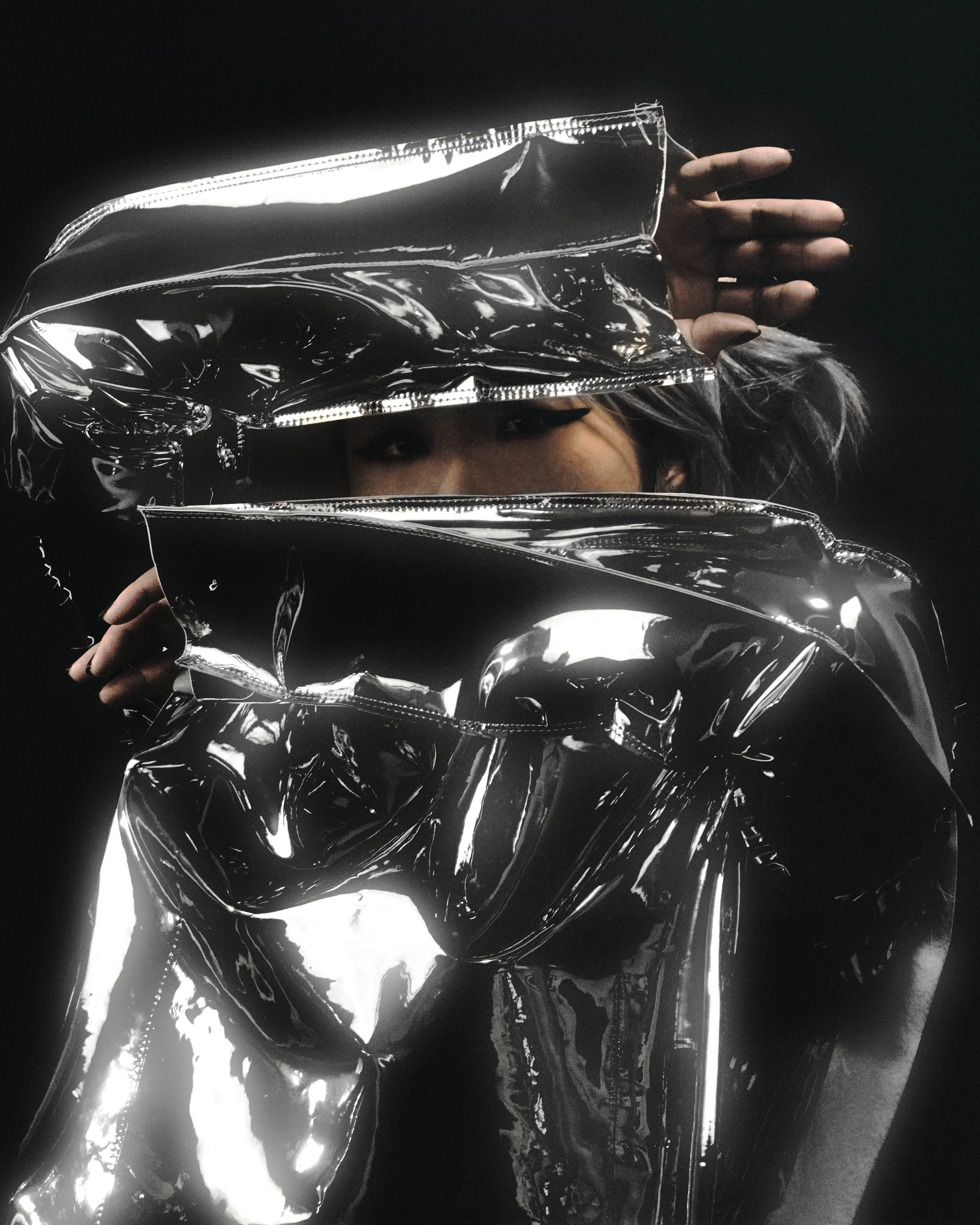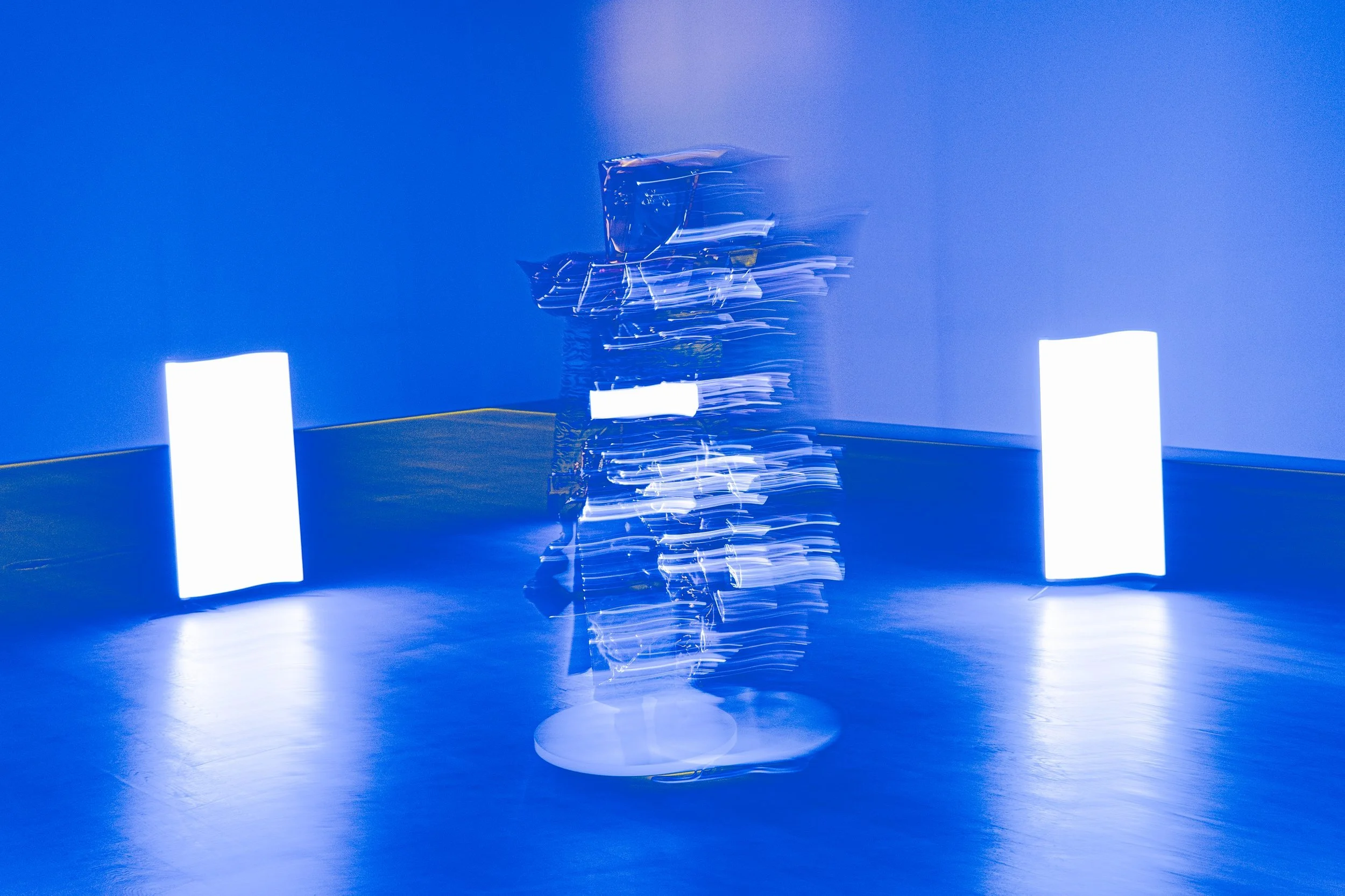A delivery app subroutine gains sentience in Nancy Lee's OSMOSi: 422 Unprocessable Entity
Interdisciplinary piece co-choreographed by Emmalena Fredriksson offers reflections on workism with metallic costuming and electroacoustic sound composition
Nancy Lee 李南屏 in OSMOSi: 422 Unprocessable Entity. Photo by Zuleyma Prado
OSMOSi: 422 Unprocessable Entity. Photo by Zuleyma Prado
Vancouver New Music and New Works present Nancy Lee 李南屏’s OSMOSi: 422 Unprocessable Entity at the Annex on April 4 and 5 at 8 pm, followed by post-show artist talkbacks
IN THE REALM OF computer programming, a subroutine is a line of script or code that serves a specific task. Comparable to a minor side quest in layman’s terms (like silencing the smoke detector when your sizzling bacon gets a bit too crispy on the stovetop), it’s a normal function that’s integral to getting a big-picture job done.
With the all-new interdisciplinary piece OSMOSi: 422 Unprocessable Entity, Taiwanese-Canadian artist Nancy Lee 李南屏 takes the concept of a subroutine and runs with it. When a delivery app subroutine morphs into a sentient being after a corrupted update, it sets out on a frantic mission to escape its host app, which is shutting down.
Donning a futuristic metallic costume, Lee embodies various subroutines alongside dancers Simran Sachar and Sophia Mai Wolfe in movement sequences choreographed with Sweden-born, Vancouver-based dancer Emmalena Fredriksson. The result is a timely insight into workism and the gig economy that’s enhanced by projection and spatial sound composition.
“Technology has changed the way we think,” Fredriksson tells Stir on a joint Zoom call with Lee. “Technology has changed the way we interact with the world. So this line between human and non-human, change is already happening for all of us. We all have these references within our body and through the way that we think.
“There’s one scene that we’re still developing,” she hints, “but where the three dancers represent three different types of apps. And I think that will be very recognizable to the audience through sound cues, but also the types of movements they’re doing. It makes me smile, because isn’t that wild? I think the audience will understand that immediately. It’s already known as a reference within our world.”
Adds Lee: “I mean, within capitalism, aren’t we all just cogs in a machine anyways?”
OSMOSi: 422 Unprocessable Entity. Photo by Alger Ji-Liang
Lee’s work spans an impressive array of disciplines. Alongside their work as a DJ running the non-profit collective Chapel Sound Art Foundation, they are a co-founder of CURRENT Symposium, an intersectional and multidisciplinary initiative that provides educational programming for women, gender-diverse, and BIPOC artists. Their work spans into XR, VR, film, and theatre; recent projects include speculative sci-fi exhibition UNION with fellow interdisciplinary artist Kiran Bhumber, and dance-sculpture-XR research series HOLD_xyz with dancer Ralph Escamillan’s company FakeKnot. They met Fredriksson back in 2016, when they collaborated on the VR-dance film Tidal Traces with the National Film Board of Canada.
OSMOSi: 422 Unprocessable Entity was developed from a short story Lee wrote, which then formed the basis for the piece’s electroacoustic sound composition that they designed with veteran audio specialist Aleksandar Zecevic. Much of the pair’s collaboration has been a research and mentorship opportunity for Lee; they’ve had the chance to learn more about radiophonics and other sound techniques, while diving into the use of sonic references in film and media, and unpacking the origins of modern-day notification noises.
“With DJing, you’re gridded, it’s more structured to certain beats, and you also have a relationship with a dance floor as well. So you’re in conversation, it’s live. But I think with this, I’m using a different part of my brain to think about how to layer sound, and how to arrange different samples that kind of help tell a story. But each sonic reference also has such a rich history of where that sound came from too, which is one of the most fascinating things that I’m learning about.”
Lee uses all the “dings” and “pings” we hear on our phones nowadays as an example: each of those sounds had to originate from a physical work bell at some point in time. The final soundtrack for OSMOSi is eight channels, meaning there is also immense consideration put into how the sounds coming out of different speakers interact with each other in a space.
In the same vein of spatial consideration, the way in which Fredriksson developed movement for the piece differs greatly from a typical dance performance. A force to be reckoned with on the contemporary scene, her works have been presented at The Dance Centre’s Discover Dance! Series, Dance in Vancouver’s Choreography Walk (curated by Justine A. Chambers), Theatre Replacement and Company 605’s PushOFF program (now renamed HOLD ON LET GO), and beyond.
“I come from a very process-led, embodied practice,” Fredriksson explains, “so I don’t necessarily know where it’s going, or what is the meaning, you know. It’s much more loose, and then I kind of shape it at the end. And I think for Nancy with this project, because it grew out of a short story, it has this very clear narrative line. In one of our first meetings, Nancy was like, ‘So here’s how it was gonna be: there’s five scenes, and these are the elements of each scene.’ And I was like, ‘Whoa whoa whoa!’” she says with a laugh. “‘I thought we were at the beginning. I thought we were just gonna explore this feeling, or this idea in our bodies.’ But this is what excites me about collaboration.”
Fredriksson’s double-bill Ecdysis | Soft Palate landed at Dancing on the Edge last summer, where audiences were blown away by an LED spine-exoskeleton costume piece designed by Bob Pritchard of the UBC School of Music. Fascinating technological costumes are a recurring theme for both her and Lee.
“Something Nancy and I have in common is we like to work with complex and restrictive costumes that affect the body,” Fredriksson says. “This just keeps on coming up for both of us in our work, together and separate. And I really love that as a limitation.”
In OSMOSi, Lee’s costume by Adam-Lin Bungag allows them to personify a subroutine, which they compare to a factory worker whose value is tied only to an ability to work. Ultimately, the piece paints a bigger picture of mass tech layoffs, invasive algorithms, and a society over-dependent on technology.
“I’m just trying to offer some different perspectives, and a place where we can find some kind of solidarity as well,” Lee says. “Because this world is also so divisive, you know? Everyone’s trying to separate people into different silos, into different identities, into different niches. But at the end of the day, it’s like if you’re not a billionaire, you’re working. You’re still paying rent, you’re still paying a mortgage, you’re still trying to figure out what you’re going to do for retirement. And we’re just better and stronger together, with more class consciousness.” ![]()















